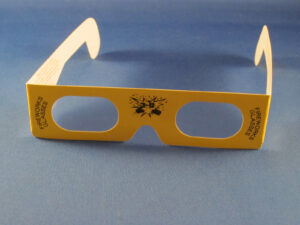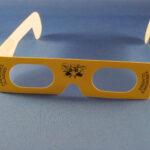Rainbow Glasses

Author(s): CCSP
Subject: Physics
Grade Level(s): Grade 3, Grade 7, Grade 8, High School
Topic: Seeing Spectra
What you need:
- Rainbow Glasses
Time Needed:
Summary:
The rainbow glasses are pairs of bright-colored spectacles that students can wear. When you put on a pair of Rainbow Glasses, and look at a light source, you see just what you would expect: rainbows! If you look carefully at the rainbows, you see that what you are observing is the spectrum of the light source. Since the dark room in the Little Shop area has a variety of different light sources, you can see a number of different effects. For instance: the phosphors on the screen of the Televised Chaos display appear yellow, but the spectrum as seen in the rainbow glasses show that they emit red light and green light-but no yellow! So red plus green makes yellow, one of the key results of the Color Mixing display!
Background
When light hits a shiny metal surface, or another smooth surface such as the surface of a pond, the light is reflected. When light travels from air into some transparent medium that is more dense than air, the light rays are bent; we say that the light is refracted. Now, when light hits obstructions that are very small, something else can happen: the light can be diffracted. If light passes through a very narrow slit, the light will spread out as it goes through.
The rainbow glasses have for their lenses plastic sheets that have a set of very small lines inscribed on them. The lines are far too small to see, but they will have an effect on the light that passes through them: they will diffract it. Now, since the lines are evenly spaced, there will be another effect: the diffracted light will make an interference pattern. We know that light can be thought of as a wave, and so it will interfere, as do other waves, making a pattern of light and dark bands. A full treatment of this is beyond the scope of this book; please consult any basic physics textbook for a full explanation.
Now, if the lenses in the glasses had a single set of lines spaced like this:
there would be a simple spectrum of the light source. Actually, you would get two spectra, one on each side of the light source:
The glasses actually have a grid of lines on them:
and so you will see the usual pair of spectra, from the vertical lines, plus a set of vertical spectra, from the horizontal lines, and two “cross” spectra, from the interaction of the two!
So, you will see several spectra. This is more complicated than what you would get with a simple diffraction grating, but it is also prettier-which is why the glasses are made this way. They are sold not as science equipment, but as “Fireworks Glasses” or “3D” glasses. The goal is to make the prettiest rainbow effect, and the grid pattern does this in spades.
Instructions / Activities:
Field Use
Usually, students put the glasses on for about five seconds, say “cool” or “fresh” or something like that, and walk on. Often, though, students will take these easily portable glasses around and use them to check out all the different exhibits-which is why we always set out several pairs!
Other Possibilities
We go back and forth as to whether to put the glasses in the dark area or the light area. Generally, when we are dealing with young children, we tend to put them in the light area. This way, it is very easy for them to see an effect, quickly. And the light sources tend to be continuous, so they get to see the usual ROYGBIV (well, there is no “I”, but that is another story … ) rainbow that they know and love. With older students, though, we tend to put them in the dark area. This means that they can look at all the spectra around. And there are a lot of different spectra to consider: sodium (Sodium Light Box), argon (Plasma Ball), neon (laser tube that is in plastic case for Lightbulb Guts), mercury (room lights that can be seen through the door), laser light (Laser Bongo and Laser Spirograph), and various phosphors on computer monitors and televisions. And then there are the continuous light sources! There are also LEDs (Static Sensor) and the IR LEDs from the Infrared Images display, which can be projected through on of the lenses. So placing the glasses in the dark area means that there is a lot of interesting physics to be considered.
Assessment:
Teacher’s Discretion
Wrap-up / Closure:
The Rainbow Glasses are a perennial favorite with the people who set up the experiments (easy, safe, cheap) and with students (fun, visually stimulating, and educational). We can always find room to set out a few pairs.
I often wear the Rainbow Glasses as I walk around the dark area of the Little Shop. There are dozens of different light sources there, and I always learn something. Looking at the spectrum of the Sodium Light Box, for instance, clearly shows how monochromatic it is. The best thing we might say for a new set of glasses, if we can use a popular metaphor, is that they show you how to look at the world differently. The Rainbow Glasses definitely do this!
Attachments:
These materials are contained in a kit in our Library!
Tags: Grade 3, Grade 7, Grade 8, High School
Categories: Physics





